Kirchhoff's Laws
Kirchhoff’s First Law
- Kirchhoff’s First Law can be expressed in the following manner:
- The sum of currents flowing into a junction is always equal to the sum of currents flowing out of the same junction
- This law is a direct consequence of the principle of conservation of charge, which dictates that the current in a circuit should remain constant when it splits or merges
- In a circuit:
- A junction refers to a point where three or more circuit paths intersect
- While a branch denotes a path that connects two junctions
- Whenever a circuit splits into two branches, the total current flowing into the branches must be equal to the current entering the circuit before the split
- In the circuit shown below, I denotes the current flowing into the circuit before the split, while I1, I2, and I3 represent the currents flowing through the respective branches. Thus, the equation I = I1 + I2 + I3 holds true:
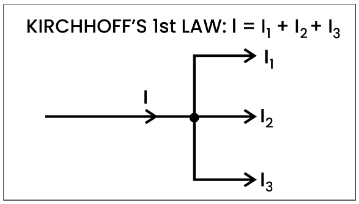
- Conservation of charge is maintained on both sides of the junction
- In a series circuit, the current remains constant at all points
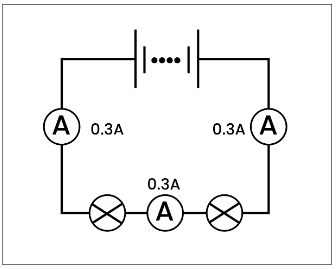
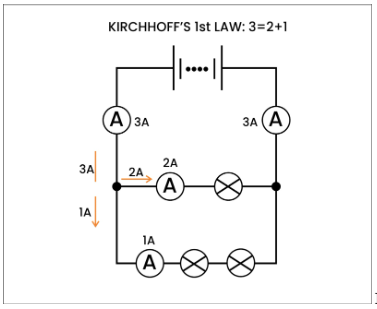
- In a parallel circuit, the current splits at the junctions, resulting in different values for each branch. Kirchhoff’s first law applies at every junction in the circuit
Kirchhoff’s Second Law
- The second law of Kirchhoff states that:
- The total electromotive force (e.m.f) in a closed circuit is equal to the sum of the potential differences in the circuit
- This law is a direct consequence of the principle of conservation of energy
- The circuit diagram below illustrates Kirchhoff’s second law, where the sum of the voltages in a closed series circuit equals the sum of the e.m.f’s:
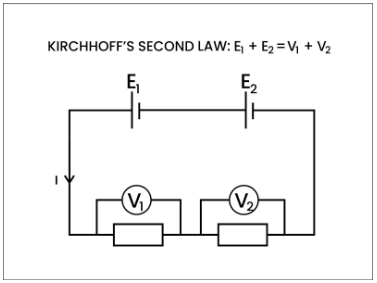
- In a series circuit, the voltage is distributed among all components based on their resistance
- The total voltage across the circuit is equal to the sum of the voltage drops across each component, which is equivalent to the e.m.f of the power supply
- In a parallel circuit, each closed loop experiences the same voltage
- The total voltage provided by the power supply is equal to the sum of the voltages across each closed loop in the parallel circuit:
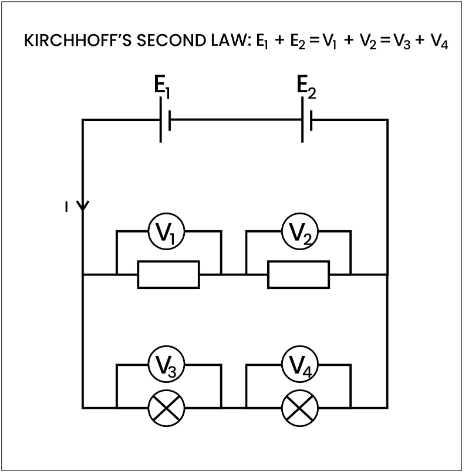
A closed circuit loop behaves like an independent series circuit and separates at a junction. A parallel circuit is composed of two or more such loops
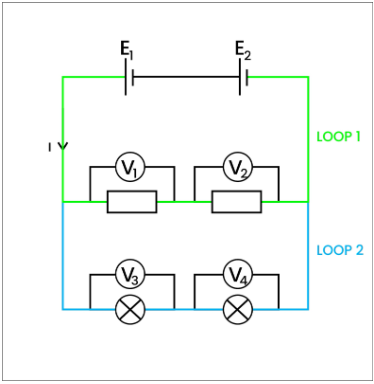
- This property makes parallel circuits very advantageous for home wiring systems because a single power source can provide the same voltage to all lights and appliances
- Even if one light or appliance fails, the voltage and current can still flow through the rest of the circuit without any interruption
Kirchhoff’s Laws are two fundamental laws that govern the behavior of current and voltage in electrical circuits. The first law, also known as Kirchhoff’s Current Law (KCL), states that the total current entering a junction in a circuit is equal to the total current leaving that junction. The second law, also known as Kirchhoff’s Voltage Law (KVL), states that the total voltage around any closed loop in a circuit is zero.
Kirchhoff’s Laws are important because they allow us to analyze and solve complex electrical circuits. By applying KCL and KVL, we can determine the currents and voltages in different parts of a circuit and predict how the circuit will behave under different conditions.
To apply Kirchhoff’s Laws, you need to first identify the different junctions and loops in the circuit. Then, you can use KCL to write equations for the currents entering and leaving each junction, and KVL to write equations for the voltages around each loop. By solving these equations simultaneously, you can determine the unknown currents and voltages in the circuit.
One common mistake is forgetting to include all the currents or voltages in the equations. Another mistake is using the wrong signs for the currents or voltages. It’s important to follow a consistent sign convention and be careful with the direction of currents and voltages. Finally, it’s important to double-check your calculations and ensure that your results make sense in the context of the circuit.
Yes, Kirchhoff’s Laws can be applied to AC circuits as long as the circuit components have a constant impedance. However, in AC circuits, the currents and voltages are represented by phasors, which are complex numbers that take into account the magnitude and phase of the signals.
You can practice applying Kirchhoff’s Laws by solving practice problems and exercises in your A-Level Physics textbook or online resources. It’s also helpful to work through examples step-by-step and to seek feedback and guidance from your teacher or tutor.





Still got a question? Leave a comment
Leave a comment